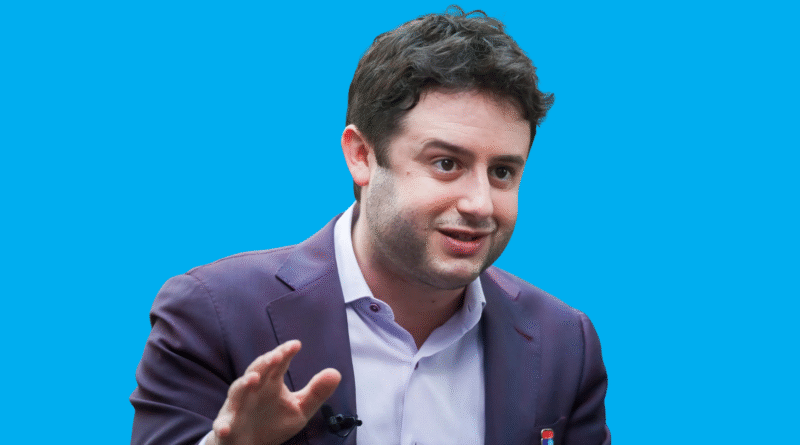Thwarted By Regulators, Vindicated By Wall Street: Design Startup Figma’s CEO Dylan Field Is Now A Multi-Billionaire
Dylan Field, co-founder and CEO of design startup Figma, has officially entered the billionaire ranks — not through an acquisition, but thanks to Wall Street’s booming confidence in the company. After a high-profile $20 billion acquisition attempt by Adobe was blocked by regulators, many doubted Figma’s future. But in a remarkable twist, the company is thriving independently, and Dylan Field’s net worth has skyrocketed.
💡 Quick Highlights
- Figma’s valuation now exceeds $25 billion, post new secondary funding rounds.
- Dylan Field’s estimated net worth: $3.5 billion (as of August 2025).
- Adobe’s failed acquisition: $20 billion offer in 2022.
- Key investors: Index Ventures, Greylock Partners, Sequoia Capital.
- Figma’s revenue (2024): Estimated $550 million, growing at 45% YoY.
- User base: Over 6 million active users, spanning design, product, and dev teams.
- Wall Street’s confidence: Figma stock demand is outpacing many public SaaS companies.
🚫 The Blocked Adobe Deal: A Regulatory Roadblock
Back in 2022, Adobe announced a $20 billion acquisition of Figma, triggering waves across the design and SaaS landscape. The deal was seen as Adobe’s strategic move to eliminate a fast-growing rival and consolidate its dominance in UI/UX tools.
However, U.S. and EU regulators raised strong antitrust concerns, arguing the merger would stifle innovation and reduce competition in design software. After over a year of regulatory pushback and scrutiny, Adobe officially terminated the deal in December 2023.
Though a $1 billion breakup fee was paid to Figma, many questioned whether the startup could survive such a high-profile collapse.
📈 Wall Street Backs Figma: Secondary Sales Reveal Soaring Valuation
Far from folding under pressure, Figma rebounded stronger. In mid-2025, a massive secondary stock sale facilitated by early investors and employees sent Figma’s valuation soaring past $25 billion, surpassing even Adobe’s acquisition offer.
This strong performance wasn’t driven by hype but by real fundamentals:
- Rapid user growth across startups, enterprises, and schools.
- Viral product-led growth (PLG) model.
- Seamless integration with development tools and workflows.
With no fresh equity raised, the valuation was driven solely by investor demand — a rare feat in today’s market.
💸 Dylan Field: From College Dropout to Billionaire CEO
Dylan Field co-founded Figma in 2012 with Evan Wallace after receiving a Thiel Fellowship to drop out of Brown University. With a vision to build design tools for the browser and for everyone, Figma started as a moonshot — but became a category-defining platform.
As Figma’s valuation soared in 2025, Field’s stake — estimated at ~14% — pushed his net worth to over $3.5 billion, making him one of the youngest self-made billionaires in tech today.
His decision to remain independent now seems prescient. Field commented in a recent interview:
“We’re building for the long run — and for everyone, not just shareholders or acquirers.”
🔍 Why Investors Love Figma
Figma’s appeal to investors is rooted in its unique product philosophy and sticky user base. Here’s why it’s become Wall Street’s SaaS darling:
- Freemium to Enterprise Funnel: Millions of users onboard for free, and convert to paying customers organically.
- Remote-first future: Real-time collaboration, cross-functional team tools, and cloud-native design workflows match future-of-work trends.
- Platform Ecosystem: Plugins, community libraries, and developer tools extend Figma far beyond just design.
- Expansion into Dev & Whiteboarding: With FigJam and Dev Mode, Figma is now eating into markets like product planning and handoff.
🌍 Market Scope & Future Roadmap
Figma’s current market includes:
- UI/UX design (~$25B)
- Collaborative whiteboarding (~$10B)
- Developer handoff & product ops (~$8B)
With global expansion in Asia-Pacific and LATAM, plus enterprise wins across Fortune 500s, analysts expect Figma’s ARR to cross $1 billion by 2027.
Future plans include:
- AI-powered design suggestions
- Integrated product roadmapping
- Mobile-first design and review tools
- Enterprise security features & compliance
🧠 Lessons From Figma’s Journey
- Not all acquisitions are necessary – staying independent can unlock higher long-term value.
- Product-led growth works – especially when paired with a community-first mindset.
- Great design is great business – Figma proved that UX tools can be billion-dollar markets.
📊 Figma at a Glance (2025)
| Metric | Value |
|---|---|
| Valuation | $25+ Billion |
| Revenue (2024) | $550 Million (est.) |
| YoY Growth | 45% |
| Users | 6M+ Active Users |
| CEO Dylan Field Net Worth | $3.5 Billion |
| Key Products | Figma, FigJam, Dev Mode |
| Competitors | Adobe XD, Sketch, Canva |
📢 How to Invest in Figma?
As of 2025, Figma remains a private company, but:
- Secondary markets occasionally offer pre-IPO shares to accredited investors.
- IPO rumors are swirling for late 2026 or early 2027, especially after recent valuations.
Interested investors can:
- Monitor private equity platforms like Forge or EquityZen.
- Follow investor funds with Figma exposure (e.g., Sequoia, a16z portfolios).
❓FAQs
Who is the CEO of Figma?
Dylan Field, co-founder and Thiel Fellow, is the CEO of Figma.
Why did the Adobe-Figma deal fail?
The $20B deal was blocked by regulatory authorities in the US and EU over antitrust concerns.
What is Figma’s latest valuation?
As of mid-2025, Figma is valued at over $25 billion following a large secondary share sale.
Is Figma going public?
Figma is currently private but is rumored to be planning an IPO in 2026 or 2027.
How much is Dylan Field worth?
Dylan Field’s estimated net worth is $3.5 billion, making him one of the youngest billionaires in tech.
What products does Figma offer?
- Figma: Cloud-based design and prototyping tool.
- FigJam: Collaborative whiteboard.
- Dev Mode: Hand-off interface for developers.
📝 Final Thoughts
Figma’s story is a lesson in resilience, product obsession, and strategic patience. From a rejected acquisition to a Wall Street success, Dylan Field and his team have proved that vision-first startups can not only survive — but thrive — without selling out.
In the years to come, Figma could reshape not just design, but how teams build and ship digital products globally.
Keep Reading:
- How Victoria’s Secret’s Les Wexner Made $2 Billion In 3 Months From AI Giant CoreWeave
- Top 10 Richest People in Israel (2025) – Billionaire List by Net Worth
- Dany Garcia: Visionary Entrepreneur, Producer, and Fitness Icon Behind Hollywood’s Power Moves
- Top 50 Richest Chinese Billionaires in 2025
- Pokémon Go Made Niantic Billions. Now It’s Ditching Gaming For AI




